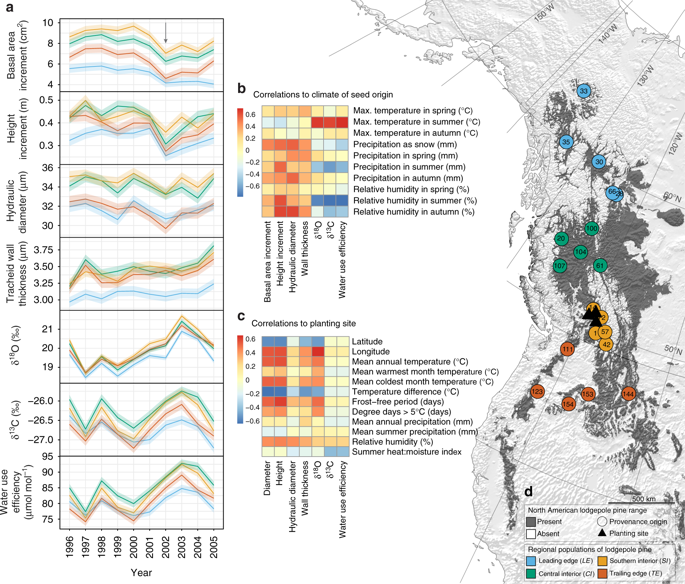当前位置:
X-MOL 学术
›
Nat. Commun.
›
论文详情
Our official English website, www.x-mol.net, welcomes your
feedback! (Note: you will need to create a separate account there.)
Northern forest tree populations are physiologically maladapted to drought.
Nature Communications ( IF 14.7 ) Pub Date : 2018-12-10 , DOI: 10.1038/s41467-018-07701-0 Miriam Isaac-Renton 1 , David Montwé 1 , Andreas Hamann 1 , Heinrich Spiecker 2 , Paolo Cherubini 3 , Kerstin Treydte 3
Nature Communications ( IF 14.7 ) Pub Date : 2018-12-10 , DOI: 10.1038/s41467-018-07701-0 Miriam Isaac-Renton 1 , David Montwé 1 , Andreas Hamann 1 , Heinrich Spiecker 2 , Paolo Cherubini 3 , Kerstin Treydte 3
Affiliation

|
Northern forests at the leading edge of their distributions may not show increased primary productivity under climate warming, being limited by climatic extremes such as drought. Looking beyond tree growth to underlying physiological mechanisms is fundamental for accurate predictions of forest responses to climate warming and drought stress. Within a 32-year genetic field trial, we analyze relative contributions of xylem plasticity and inferred stomatal response to drought tolerance in regional populations of a widespread conifer. Genetic adaptation leads to varying responses under drought. Trailing-edge tree populations produce fewer tracheids with thicker cell walls, characteristic of drought-tolerance. Stomatal response explains the moderate drought tolerance of tree populations in central areas of the species range. Growth loss of the northern population is linked to low stomatal responsiveness combined with the production of tracheids with thinner cell walls. Forests of the western boreal may therefore lack physiological adaptations necessary to tolerate drier conditions.
中文翻译:

北方森林树木种群在生理上不适应干旱。
在气候变暖的情况下,分布最前沿的北部森林可能不会表现出初级生产力的增加,因为受到干旱等极端气候的限制。除了树木生长之外,着眼于潜在的生理机制对于准确预测森林对气候变暖和干旱胁迫的反应至关重要。在一项为期 32 年的遗传田间试验中,我们分析了木质部可塑性的相对贡献,并推断了气孔对广泛分布的针叶树区域种群耐旱性的反应。遗传适应导致干旱下的不同反应。后缘树木种群产生的管胞较少,细胞壁较厚,具有耐旱性。气孔反应解释了该物种范围中心区域树木种群的中等耐旱性。北方种群的生长丧失与气孔反应性低以及细胞壁较薄的管胞的产生有关。因此,北方寒带西部的森林可能缺乏忍受干燥条件所必需的生理适应能力。
更新日期:2018-12-10
中文翻译:

北方森林树木种群在生理上不适应干旱。
在气候变暖的情况下,分布最前沿的北部森林可能不会表现出初级生产力的增加,因为受到干旱等极端气候的限制。除了树木生长之外,着眼于潜在的生理机制对于准确预测森林对气候变暖和干旱胁迫的反应至关重要。在一项为期 32 年的遗传田间试验中,我们分析了木质部可塑性的相对贡献,并推断了气孔对广泛分布的针叶树区域种群耐旱性的反应。遗传适应导致干旱下的不同反应。后缘树木种群产生的管胞较少,细胞壁较厚,具有耐旱性。气孔反应解释了该物种范围中心区域树木种群的中等耐旱性。北方种群的生长丧失与气孔反应性低以及细胞壁较薄的管胞的产生有关。因此,北方寒带西部的森林可能缺乏忍受干燥条件所必需的生理适应能力。











































 京公网安备 11010802027423号
京公网安备 11010802027423号